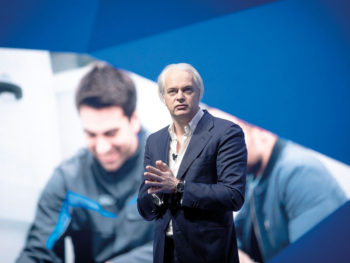Following a record 2018, with 126,000 vans and pickups registered in the UK, Ford of Europe’s general manager for commercial vehicles, Hans Schep, tells VFW how the company is aiming to be one step ahead of an ever-changing market.

Partnerships
Commercial vehicle usage is diversifying, and Schep believes partnerships are vital to meet consumer needs. The UK is an advanced market; the first with specialist Transit Centres, now encompassing 950 sites across Europe, and an early adopter of leasing among smaller fleets. Ford is extending that offer to include mobile servicing, and working closely with dealer partners.
“We are currently implementing a downtime management tool which enables dealers to access resources from the entire Ford organisation, from the parts team to specialist engineers, to get every vehicle back on the road as soon as possible,” he says.
Partnerships also broaden the product offer. Ford recently started working towards a range of CVs co-developed with Volkswagen to share expertise and cost, and Schep says plans are underway to double its network of 100 accredited converters by 2020. Many will be pan-European partnerships, offering the same conversions through its dealers across the region.
Connectivity
Ford will offer built-in modems on all CVs later this year, exchanging data with the company’s own cloud-based fleet management system. This will enable it to offer its own telematics solution for fleets, including real-time health checks, or to supply a tailored bundle of data to third party software if customers prefer.
Schep says the next step is broadening its offer for small fleets. A professional version of its consumer-focused FordPass smartphone app is due within months, enabling up to five vehicles to be monitored at once. Real-time data about vehicle health, taken from on-board sensors, will underpin usage-based maintenance and early fault detection, both designed to reduce downtime.
“As we introduce our connected Transit and FordPass Pro later this year, that’s the time to put those services in place,” he says. “We have a list of key things for breakdowns – diesel particulate filters and oil are two of the main items – so we’re starting by bringing those in, and there are opportunities to bring in items like batteries later on.”
Beyond diesel
Electrification isn’t taking hold as quickly with CVs as it is with cars, but Schep says ever-changing regulations – increasingly set at a local level – require a similarly wide range of powertrains. Petrol uptake is increasing in the Connect and Courier, while the larger Transit and Transit Custom will gain 48-volt ‘mild hybrid’ diesel technology this summer, claiming an 8% fuel economy improvement (versus a diesel engine) for urban fleets.
“Rather than betting the farm on a few propulsion solutions, we’re investing in pilots and partnering with third parties. It’s interesting, coming from a business where you can’t make mistakes because it’s capital-intensive, that we’re switching to a different approach where you have to try many things to see what the future will look like.”
Plug-ins are en route, too. Fleet trials of the Transit Custom PHEV are ongoing London, with feedback informing a more powerful electric motor and demand for geofencing its 31-mile electric range when the production model launches late this year. In 2021, Ford will introduce a full-size electric Transit with a range of bodystyles and a “competitive” payload, Schep says. This will incorporate expertise from DHL’s Transit-based StreetScooter electric delivery vehicle, of which almost 2,000 are already in use.
But, he adds, it’s vital for policymakers to work with manufacturers. “When things change, it’s difficult and messy at the beginning. We need to get through this to figure out how we collectively work out a responsible solution for our cities.”

